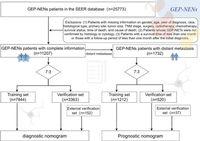A new study has successfully developed and validated a risk prediction model for distant metastasis and prognosis in gastroenteropancreatic neuroendocrine neoplasms (GEP-NENs), a subset of neuroendocrine tumors known for their heterogeneity and potential aggressiveness. Researchers utilized extensive patient data from the Surveillance, Epidemiology, and End Results (SEER) database to construct this predictive model, with an aim to enhance clinical outcomes for affected patients.
Neuroendocrine neoplasms, including GEP-NENs, have shown an alarming increase in incidence over the years. Data from the SEER database indicates that the incidence of neuroendocrine tumors in the U.S. rose from 5.25 per 100,000 in 2004 to approximately 8.4 per 100,000 by 2016. GEP-NENs, which account for 55-70% of all neuroendocrine tumors, pose significant treatment challenges, particularly due to their tendency for metastasis. Approximately one-third of patients present with distant metastasis at the time of diagnosis.
The study analyzed data from 11,207 patients diagnosed with GEP-NENs from 2010 to 2015 within the SEER database. To robustly validate the findings, the research also included an independent cohort of 152 patients from the China-Japan Union Hospital of Jilin University, diagnosed between January 2010 and January 2018.
Researchers employed univariate and multivariate logistic regression analyses to identify independent risk factors associated with distant metastasis. Key predictors included the primary tumor site, tumor grade, pathological type, tumor size, T stage, and N stage. The study conclusively demonstrated that characteristics such as these significantly impact the likelihood of metastasis in GEP-NENs.
In addition to identifying risk factors for metastasis, the study developed a prognostic model by utilizing Cox regression analyses that highlighted crucial prognostic factors for patients with distant metastasis. Notably, N stage, tumor size, primary site surgery, and tumor grade were identified as independent prognostic indicators. The authors of the article noted, “We developed an effective predictive model to assess distant metastasis and prognosis in GEP-NENs.”
The finalized nomogram—a visual calculation tool—enables clinicians to estimate the probability of distant metastasis and predict overall survival (OS) for GEP-NEN patients. The model achieved an area under the ROC curve (AUC) of 0.85 during internal training validation and 0.84 during external validation, indicating strong predictive accuracy and clinical utility.
The nomogram grading system assigns risk scores to individual patients based on their clinical characteristics, helping physicians customize treatment plans and anticipate potential outcomes. Kaplan–Meier analysis revealed significant differences in survival between patients categorized into high-risk and low-risk groups based on the scoring system.
The authors emphasized that, “This model assists clinicians in evaluating the risk of distant metastasis and in assessing patient prognosis,” thus enhancing the individualization of treatment approaches in managing GEP-NENs.
Despite the encouraging results, the study authors acknowledged potential limitations, including the retrospective nature of their analysis and the absence of certain clinical variables like specific treatment regimens in available databases. They stress the necessity for ongoing research and larger multicenter studies to further establish the nomogram's applicability and effectiveness in diverse populations.
In conclusion, the newly developed nomogram for predicting distant metastasis and overall survival in GEP-NENs represents a promising advancement in oncological predictive models, offering a more nuanced approach to assessing patient outcomes and guiding clinical treatment pathways.




